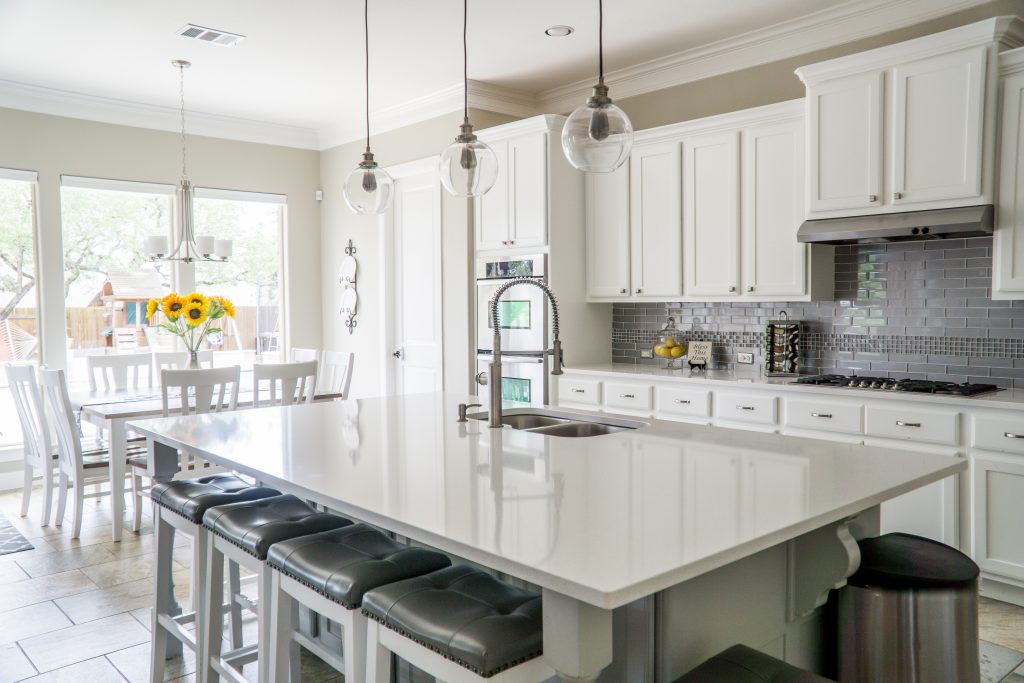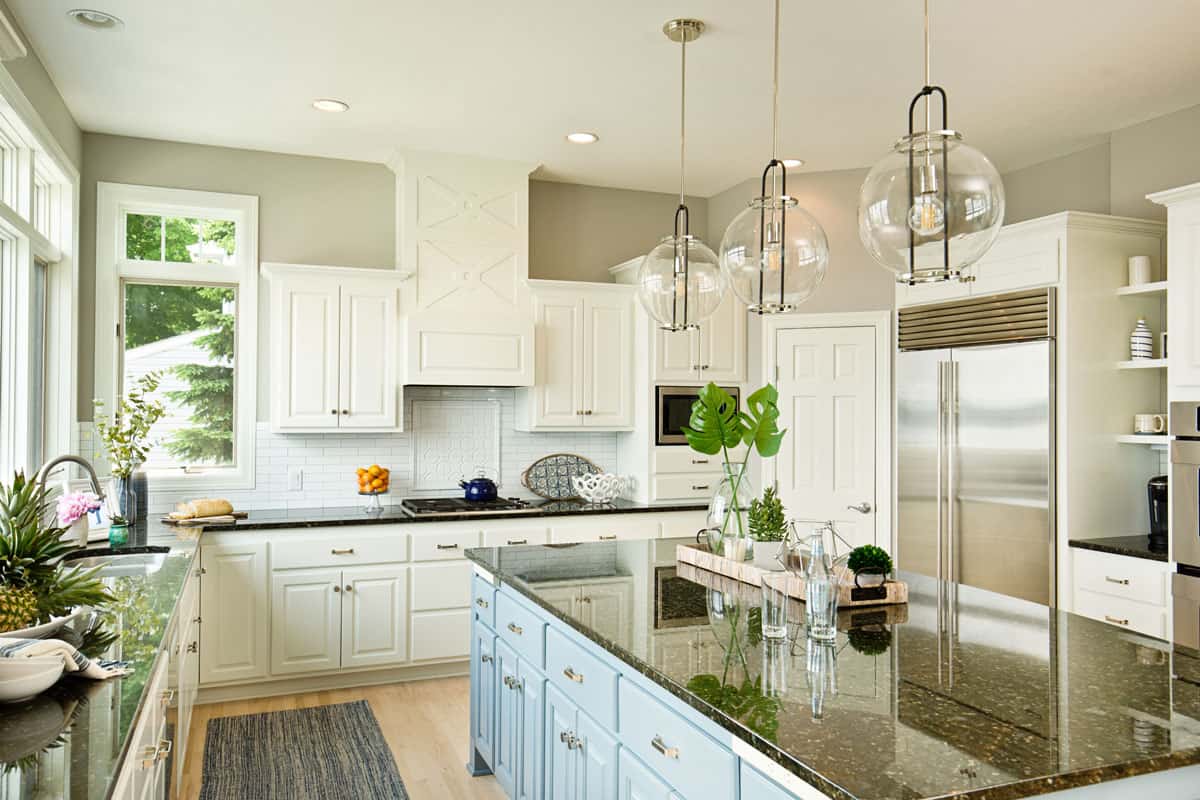Benefits of Kitchen Cabinets Reaching the Ceiling: Kitchen Cabinets Up To Ceiling

Maximizing vertical space in your kitchen is a smart move, and opting for cabinets that reach the ceiling is a design choice that offers a multitude of benefits. This approach goes beyond mere aesthetics; it’s about creating a functional and organized kitchen that truly works for you.
Increased Storage Capacity
Ceiling-high cabinets offer an abundance of storage space, a crucial element for any kitchen. This added storage capacity allows you to keep your kitchen organized and clutter-free, ensuring that all your kitchen essentials have a designated place.
- Efficient Use of Space: By utilizing the often-overlooked space between the top of your cabinets and the ceiling, you eliminate wasted vertical space, making the most of your kitchen’s square footage.
- Minimized Clutter: With ample storage, you can easily store appliances, cookware, and even seasonal items, preventing clutter from accumulating on countertops and creating a more organized and functional kitchen environment.
- Enhanced Functionality: Increased storage capacity can significantly improve the functionality of your kitchen. You’ll have easier access to frequently used items, reducing the need to constantly dig through drawers and cabinets.
Aesthetics and Visual Cohesion
Ceiling-high cabinets contribute to a visually cohesive and harmonious kitchen space. By extending the cabinetry to the ceiling, you create a sense of continuity and unity, enhancing the overall aesthetic appeal of your kitchen.
- Streamlined Appearance: The unbroken lines of ceiling-high cabinets create a clean and uncluttered look, making your kitchen appear larger and more organized.
- Enhanced Visual Appeal: By eliminating the visual break between the top of your cabinets and the ceiling, you create a sense of balance and proportion, enhancing the overall aesthetic appeal of your kitchen.
- Improved Light Reflection: Ceiling-high cabinets can reflect light, making your kitchen feel brighter and more spacious. This is particularly beneficial for kitchens with limited natural light.
Design Considerations for Ceiling-High Cabinets

Installing cabinets that reach the ceiling can dramatically transform your kitchen’s look and feel, maximizing storage space and creating a sleek, modern aesthetic. However, careful planning is essential to ensure these cabinets seamlessly integrate with your existing kitchen design and achieve the desired visual impact.
Cabinet Style Selection
Choosing the right cabinet style is crucial for achieving a cohesive look. Consider the overall design of your kitchen and existing elements, such as countertops, backsplash, and flooring. For a contemporary feel, sleek, minimalist cabinets with flat panels and simple hardware are ideal. Traditional kitchens often benefit from more ornate cabinets with raised panels, decorative moldings, and intricate hardware. Consider the following points:
- Cabinet Doors: Flat panel doors offer a modern, clean aesthetic, while raised panel doors add a traditional touch. Shaker-style cabinets provide a versatile option that blends modern and traditional elements.
- Cabinet Finishes: Matte finishes are popular for their understated elegance, while glossy finishes add a touch of glamour. Consider the color scheme of your kitchen and the overall ambiance you want to create.
- Hardware: Choose hardware that complements the cabinet style and your kitchen’s overall design. Simple, modern pulls work well with contemporary cabinets, while ornate knobs and handles are more suited to traditional styles.
Integration with Existing Elements
Integrating ceiling-high cabinets seamlessly into your existing kitchen design requires careful consideration of the surrounding elements.
- Countertops: The countertop material and color should complement the cabinet finishes. For example, a sleek, modern countertop like quartz or granite pairs well with minimalist cabinets.
- Backsplash: The backsplash should create a visual flow with the cabinets and countertop. A simple, neutral backsplash allows the cabinets to take center stage, while a patterned backsplash adds visual interest and texture.
- Flooring: The flooring material and color should complement the overall design scheme. Light-colored flooring can make the kitchen feel more spacious, while darker flooring adds a touch of sophistication.
Material and Finish Considerations
The materials and finishes used for ceiling-high cabinets play a significant role in determining the overall aesthetic and durability.
- Cabinet Material: Wood cabinets offer warmth and durability, while thermofoil cabinets are more affordable and resistant to moisture. Consider the climate and your budget when selecting the material.
- Cabinet Finish: Paint, stain, or veneer can be used to achieve different finishes. Consider the level of maintenance required for each option and the desired aesthetic.
- Hardware: Choose hardware that complements the cabinet style and your kitchen’s overall design. Stainless steel, nickel, or bronze are popular choices for modern kitchens, while brass or pewter hardware adds a touch of traditional elegance.
Design Tips for Seamless Integration
Incorporating ceiling-high cabinets seamlessly into your kitchen requires a thoughtful approach to design. Consider the following tips:
- Maintain Visual Flow: Use consistent materials and finishes throughout the kitchen to create a cohesive look. For example, if you choose wood cabinets, consider using wood flooring or countertops.
- Break Up Verticality: Consider incorporating horizontal elements, such as open shelving or a decorative molding, to break up the vertical lines of the cabinets and create a more balanced look.
- Add Lighting: Adequate lighting is essential for showcasing the cabinets and creating a welcoming atmosphere. Consider using under-cabinet lighting, pendant lights, or recessed lighting.
- Consider Functionality: Plan the layout and storage solutions carefully to ensure the cabinets are both functional and aesthetically pleasing.
Practical Aspects of Ceiling-High Cabinets

Taking the plunge into ceiling-high cabinets requires careful planning and execution to ensure optimal functionality and longevity. From meticulous measurements to professional installation, this section delves into the practical considerations that make this design choice a success.
Measuring and Planning for Installation
Accurate measurements are crucial for seamless installation of ceiling-high cabinets. The following steps provide a comprehensive guide for achieving precise results:
- Measure the Available Space: Start by measuring the width, depth, and height of the intended cabinet space. Remember to account for any existing obstructions, such as electrical outlets or plumbing fixtures.
- Consider Ceiling Height Variations: If your ceiling height is uneven, factor in the lowest point for accurate cabinet sizing. This ensures a consistent appearance and avoids potential gaps.
- Plan Cabinet Placement: Determine the desired location and arrangement of your cabinets. Consider the flow of traffic, appliance placement, and accessibility when planning your layout.
- Factor in Door Swing Clearance: Ensure sufficient space for doors to open fully without obstructing walkways or other cabinets.
- Utilize Online Planning Tools: Online kitchen planning tools can assist in visualizing your cabinet layout and help you make informed decisions regarding size and placement.
Professional Installation: Importance and Impact
Professional installation is highly recommended for ceiling-high cabinets. Skilled professionals bring expertise and precision to the installation process, ensuring:
- Precise Alignment and Leveling: Professional installers possess the tools and knowledge to ensure cabinets are perfectly aligned and level, enhancing both aesthetics and functionality.
- Structural Integrity: Ceiling-high cabinets require secure attachment to walls and ceilings. Professionals utilize proper techniques and materials to guarantee stability and prevent potential damage.
- Minimizing Risk of Damage: Installing ceiling-high cabinets can be challenging and potentially risky. Professional installers are equipped to handle the task safely and efficiently, reducing the chance of injury or damage to your kitchen.
- Warranty Protection: Many cabinet manufacturers offer warranties that are often contingent upon professional installation. This provides peace of mind and ensures that your cabinets are protected against defects.
Cabinet Materials: Pros and Cons, Kitchen cabinets up to ceiling
The choice of cabinet material significantly impacts the overall aesthetic, durability, and cost of your kitchen. Here’s a comparison of popular materials for ceiling-high cabinets:
| Material | Pros | Cons | Suitability for Ceiling-High Installations |
|---|---|---|---|
| Wood (Solid or Engineered) | Natural beauty, durability, wide range of styles, refinishable | Can be expensive, susceptible to moisture damage, requires regular maintenance | Highly suitable for ceiling-high cabinets, providing both aesthetics and durability. |
| Laminate | Cost-effective, durable, moisture-resistant, wide range of colors and finishes | Can appear less luxurious, less customizable than wood, prone to scratches and chips | Suitable for ceiling-high cabinets, offering a balance of affordability and practicality. |
| Thermofoil | Durable, moisture-resistant, smooth finish, easy to clean | Limited color options, less customizable than wood, can appear less sophisticated | Suitable for ceiling-high cabinets, providing a durable and moisture-resistant option. |
| Melamine | Budget-friendly, durable, scratch-resistant, easy to clean | Limited style options, can appear less sophisticated, less customizable | Suitable for ceiling-high cabinets, offering an affordable and practical choice. |
Accessing and Utilizing Ceiling-High Storage
Maximizing the functionality of ceiling-high cabinets requires practical solutions for accessing and utilizing the upper storage spaces. Here are some tips:
- Step Stools or Ladders: Invest in a sturdy step stool or ladder specifically designed for kitchen use. This ensures safe and easy access to upper shelves.
- Pull-Down or Lift-Up Mechanisms: Consider incorporating pull-down or lift-up mechanisms for hard-to-reach shelves. These systems allow for easy access without the need for a ladder.
- Vertical Storage Solutions: Utilize vertical storage solutions such as stackable bins, turntables, and pull-out shelves to maximize space and organize items efficiently.
- Clear Labeling: Clearly label all containers and shelves to ensure quick and easy identification of items. This helps streamline storage and retrieval processes.
Kitchen cabinets up to ceiling – Maximizing storage in your kitchen with cabinets that reach the ceiling can be a dream come true, but it also requires careful attention to detail. Securing those doors with cabinet door panel clips ensures they stay put and maintain a clean, streamlined look.
These clips are a simple yet effective way to keep your upper cabinets looking their best and functioning flawlessly.
Kitchen cabinets reaching to the ceiling are a popular choice for maximizing storage space, creating a sense of grandeur, and achieving a streamlined aesthetic. If you’re on a budget, consider exploring the options available at big lots kitchen cabinets for affordable and stylish solutions.
With a little planning and creativity, you can achieve the look you desire without breaking the bank, and enjoy the benefits of maximizing your kitchen’s vertical space.
